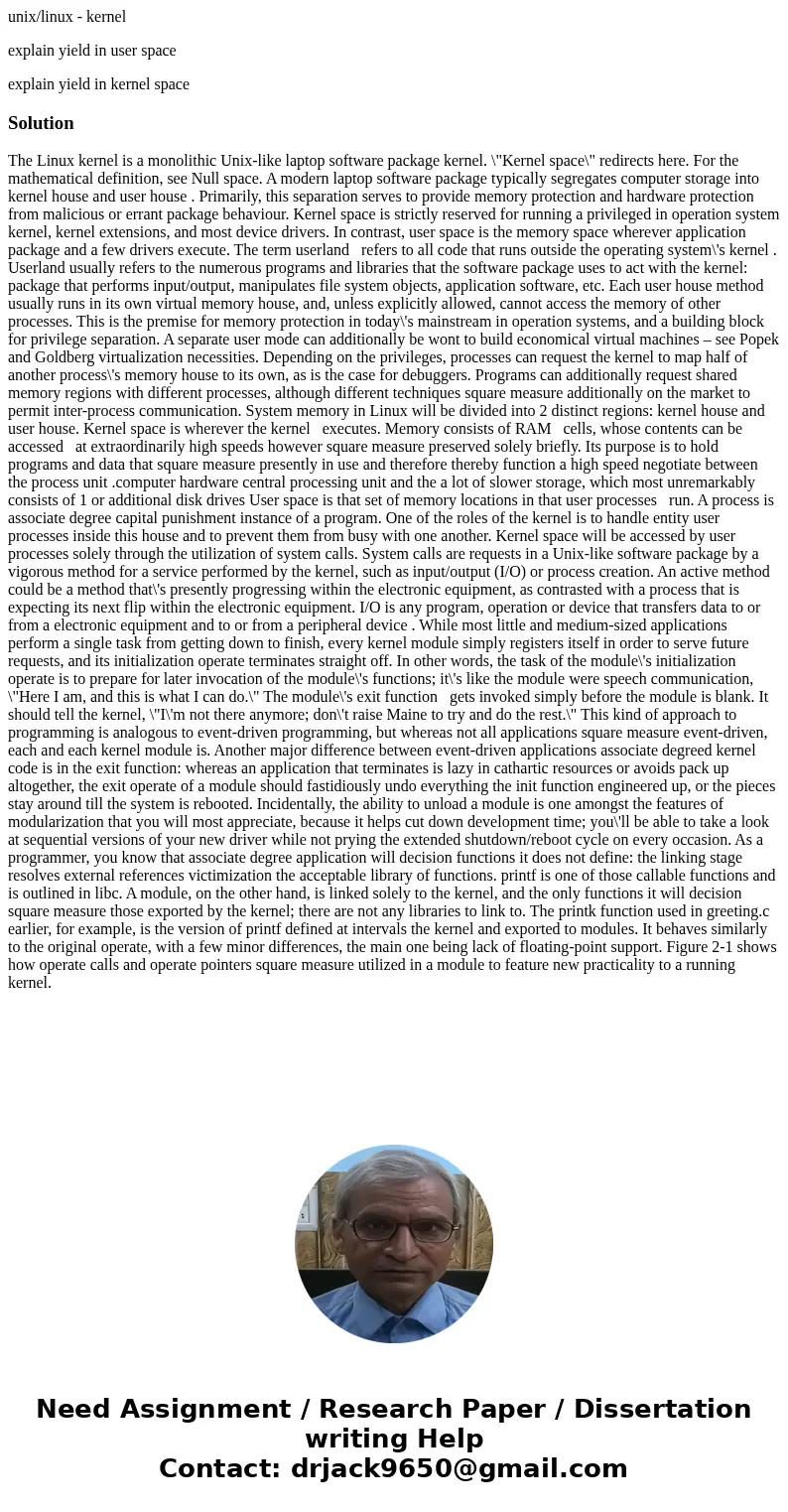unixlinux kernel explain yield in user space explain yield
unix/linux - kernel
explain yield in user space
explain yield in kernel space
Solution
The Linux kernel is a monolithic Unix-like laptop software package kernel. \"Kernel space\" redirects here. For the mathematical definition, see Null space. A modern laptop software package typically segregates computer storage into kernel house and user house . Primarily, this separation serves to provide memory protection and hardware protection from malicious or errant package behaviour. Kernel space is strictly reserved for running a privileged in operation system kernel, kernel extensions, and most device drivers. In contrast, user space is the memory space wherever application package and a few drivers execute. The term userland refers to all code that runs outside the operating system\'s kernel . Userland usually refers to the numerous programs and libraries that the software package uses to act with the kernel: package that performs input/output, manipulates file system objects, application software, etc. Each user house method usually runs in its own virtual memory house, and, unless explicitly allowed, cannot access the memory of other processes. This is the premise for memory protection in today\'s mainstream in operation systems, and a building block for privilege separation. A separate user mode can additionally be wont to build economical virtual machines – see Popek and Goldberg virtualization necessities. Depending on the privileges, processes can request the kernel to map half of another process\'s memory house to its own, as is the case for debuggers. Programs can additionally request shared memory regions with different processes, although different techniques square measure additionally on the market to permit inter-process communication. System memory in Linux will be divided into 2 distinct regions: kernel house and user house. Kernel space is wherever the kernel executes. Memory consists of RAM cells, whose contents can be accessed at extraordinarily high speeds however square measure preserved solely briefly. Its purpose is to hold programs and data that square measure presently in use and therefore thereby function a high speed negotiate between the process unit .computer hardware central processing unit and the a lot of slower storage, which most unremarkably consists of 1 or additional disk drives User space is that set of memory locations in that user processes run. A process is associate degree capital punishment instance of a program. One of the roles of the kernel is to handle entity user processes inside this house and to prevent them from busy with one another. Kernel space will be accessed by user processes solely through the utilization of system calls. System calls are requests in a Unix-like software package by a vigorous method for a service performed by the kernel, such as input/output (I/O) or process creation. An active method could be a method that\'s presently progressing within the electronic equipment, as contrasted with a process that is expecting its next flip within the electronic equipment. I/O is any program, operation or device that transfers data to or from a electronic equipment and to or from a peripheral device . While most little and medium-sized applications perform a single task from getting down to finish, every kernel module simply registers itself in order to serve future requests, and its initialization operate terminates straight off. In other words, the task of the module\'s initialization operate is to prepare for later invocation of the module\'s functions; it\'s like the module were speech communication, \"Here I am, and this is what I can do.\" The module\'s exit function gets invoked simply before the module is blank. It should tell the kernel, \"I\'m not there anymore; don\'t raise Maine to try and do the rest.\" This kind of approach to programming is analogous to event-driven programming, but whereas not all applications square measure event-driven, each and each kernel module is. Another major difference between event-driven applications associate degreed kernel code is in the exit function: whereas an application that terminates is lazy in cathartic resources or avoids pack up altogether, the exit operate of a module should fastidiously undo everything the init function engineered up, or the pieces stay around till the system is rebooted. Incidentally, the ability to unload a module is one amongst the features of modularization that you will most appreciate, because it helps cut down development time; you\'ll be able to take a look at sequential versions of your new driver while not prying the extended shutdown/reboot cycle on every occasion. As a programmer, you know that associate degree application will decision functions it does not define: the linking stage resolves external references victimization the acceptable library of functions. printf is one of those callable functions and is outlined in libc. A module, on the other hand, is linked solely to the kernel, and the only functions it will decision square measure those exported by the kernel; there are not any libraries to link to. The printk function used in greeting.c earlier, for example, is the version of printf defined at intervals the kernel and exported to modules. It behaves similarly to the original operate, with a few minor differences, the main one being lack of floating-point support. Figure 2-1 shows how operate calls and operate pointers square measure utilized in a module to feature new practicality to a running kernel.
 Homework Sourse
Homework Sourse